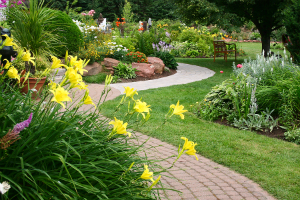Designing a garden using Australian native plants can be a very satisfying experience
Story: Arthur Lathouris, FAILDM
Australian native plants stir an enormous amount of emotion. Some people love them and would have nothing else, while others don’t want a native anywhere in their garden. As a garden designer and plant lover, I find them both a delight and a challenge. I love using them because there are so many beautiful species and varieties available these days and, yes, I even mix them with exotics.
They’re very versatile and can be used in a range of situations including formal settings, perennial-style gardens and free-flowing informal gardens. Then, of course, there’s the debate about using a range of native plants from all over the country or using just the species which grow in your local area (endemic).
I like using a range of plants as long as those selected for a particular garden don’t have the potential to become weeds in the local environment. Many plants may be well-behaved in one area but can be rampant weeds somewhere else. Local councils usually have a list of plants that are troublesome and undesirable in their area.
If selected carefully, Australian native plants can fill almost any requirement of a garden design with a broad range of trees, shrubs, groundcovers, climbers, grasses and ferns available at local and specialist nurseries.
This broad choice allows a wide range of form, texture, colour, leaf and flower type. The resulting effect within the garden can vary from a neatly clipped hedge of lilly pilly to the bold form of the Gymea lily, from the soft, subtle, white blooms of waxflowers and westringias to the eye-catching reds of bottlebrush and grevillea. From majestic tall eucalypts to ground-hugging banksias, the variety is enormous.
I’m currently experimenting with combining a variety of natives with perennials in one garden and the results are pleasing. I’ve included a range of grasses (Poa ‘Suggan Buggan’, Lomandra longifolia ‘Tanika’, Lomandra confertifolia spp. rubiginosa ‘Seascape’, Lomandra longifolia ‘Katrinus’ Dianella ‘Breeze’) and kangaroo paws (Anigozanthos).
Shrubs include the purple foliage hop bush (Dodonaea viscosa purpurea) and the silvery grey foliage of the dwarf cushion bush (Leucophyta brownii). There are also croweas, boronias and melaleucas as well as the very delicate white myrtle (Hypocalymma angustifolia) and the multi-coloured flowers of the flame pea (Chorizema cordatum). Chrysocephalum apiculatum, with its lovely bright-yellow button-like flowers and grey foliage, forms a delightful groundcover, as does Brachycome multifida with its blue and yellow daisy flowers. Both of these daisy-like plants flower for very long periods, starting in spring.
These native plants are planted among lavender, daylily, Penstemon, Aster, Achillea, Dahlia ‘Bishop of Llandaff’, echinacea, a variety of salvias, cordylines and hebes. It may sound like a bit of a mish-mash but I think it’s developing beautifully. There is a large variety of plants and a riot of colours (both soft and bold) but they do work well together.
If such bold strokes don’t appeal to you and you’d prefer a more subtle, traditional look for your garden, that can be done as well using natives. There are numerous lilly pillies, from small to large, for that elegant hedge. Acmena smithii ‘Minor’ or a variety of Syzygium, for example, clip up very nicely for a medium to large hedge. If you’d like to get away from box hedging (which makes a beautiful reliable hedge but is perhaps overused), you can try Acmena ‘Allyn Magic’ with its reddish-bronze new growth or Syzygium ‘Tiny Trev’.
Bottlebrush, westringia and a variety of grevilleas have all been used for hedges, but one stunning example I’ve admired for years is Banksia ericifolia clipped to about 2m and flowering for many months.
I also like to use grasses for “hedging” with Lomandra longifolia ‘Tanika’ being a favourite for a soft, informal edge. Dianellas can also be very appealing used as edging.
If you’re adventurous and creative, Australian native plants can be used in so many satisfying ways.
About the author: Arthur Lathouris is a garden designer based in the Blue Mountains and the president of the Australian Institute of Landscape Designers & Managers.



